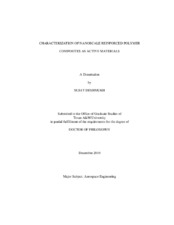| dc.description.abstract | Single walled carbon nanotube (SWNT)-based polymer nanocomposites have generated a lot of interest as potential multifunctional materials due to the exceptional physical properties of SWNTs. To date, investigations into the electromechanical response of these materials are limited. Previous studies have shown marginal improvements in the electromechanical response of already electroactive polymers (EAPs) with addition of SWNTs. However, in general, disadvantages of EAPs such as high actuation electric field, low blocked stress and low work capacity remain unaddressed.
This dissertation targets a comprehensive investigation of the electromechanical response of SWNT-based polymer nanocomposites. Specifically, the study focuses on incorporating SWNTs in three polymeric matrices: a non-polar amorphous polyimide (CP2), a polar amorphous polyimide ((-CN) APB-ODPA), and a highly polar semicrystalline polymer (PVDF). In the first step, emergence of an electrostrictive response is discovered in the non-polar polyimide CP2 in the presence of SWNTs. Transverse and longitudinal electrostrictive coefficients are measured to be six orders of magnitude higher than those of known electrostrictive polymers like polyurethane and P(VDF-TrFE) at less than 1/100th of the actuation electric fields.
Next, the effect of the polymer matrix on the electrostrictive response is studied by focusing on the polar (-CN) APB-ODPA. A transverse electrostriction coefficient of 1.5 m2/MV2 is measured for 1 vol percent SWNT- (-CN) APB-ODPA, about twice the value found for 1 vol percent SWNT-CP2. The high value is attributed to higher dipole moment of the (-CN) APB-ODPA molecule and strong non-covalent interaction between the SWNTs and (-CN) APB-ODPA matrix.
Finally, polyvinylidene fluoride (PVDF) matrix is selected as a means to optimize the electrostrictive response, since PVDF demonstrates both a high dipole moment and a strong non-covalent interaction with the SWNTs. SWNT-PVDF nanocomposites fared better than SWNT-CP2 nanocomposites but had comparable response to SWNT-(-CN) APB-ODPA nanocomposites. This was attributed to comparable polarization in both the polar nanocomposite systems. To maximize the SWNT-PVDF response, SWNT-PVDF samples were stretched leading to increase in the total polarization of the nanocomposite samples and decrease in the conductive losses. However, the dielectric constant also decreased after stretching due to disruption of the SWNT network, resulting in a decrease of the electrostrictive response. | en |


